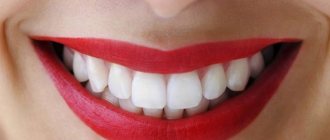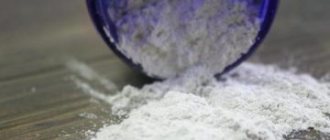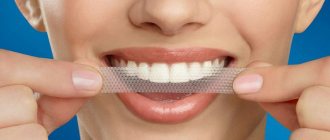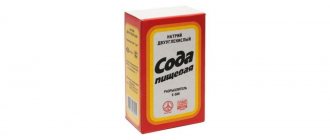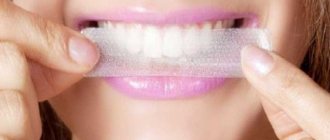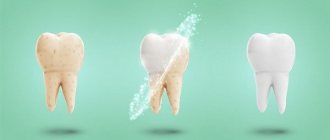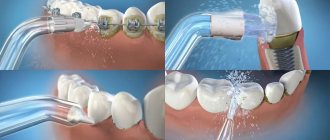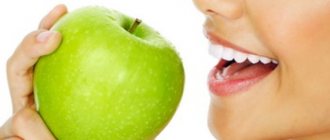Types of teeth whitening in dentistry
Professional teeth whitening involves performing procedures in a dental office and under the direct supervision of a specialist. In this case, mechanical or chemical effects may be exerted on the tooth enamel. The effectiveness of the latter can be enhanced by the penetrating ability of ultrasound, laser or light, which act as an activator and conductor for the reagent that penetrates deep into the enamel.
Today there are a number of popular whitening methods, each of which has its own advantages and disadvantages. Their descriptions will help you give preference to one or another procedure.
Photobleaching
One of the “youngest” whitening methods. During its use, a special whitening gel is applied to the visible surface of the teeth, with a minimum concentration of hydrogen peroxide, which, under the direct influence of light emitted by a halogen lamp, is activated and penetrates deep into the enamel, while breaking down its pigment plaque. This procedure is often called ZOOM whitening, since the ZOOM-4 series device can be used for it. You can sign up for a whitening procedure using the ZOOM-4 device on our website
Advantages
- Quick visible effect.
- Suitable for patients with sensitive tooth enamel.
- If you follow the dentist's recommendations, the effect lasts up to 2 years.
Flaws
- The duration of the procedure is 1.5 – 2 hours in the dentist’s chair.
- Unpleasant taste in the mouth after the procedure.
- There may be an effect of “unnatural whiteness” of teeth, with a blue tint.
What is photobleaching
Photobleaching is a modern way to make enamel lighter using a special gel, the particles of which become active when exposed to special lighting. At home, this method is not used, since it requires certain equipment in the form of a brightening lamp. The ability to whiten enamel by several tones (10-12) depends on the choice of gel.
Pros and cons of this method
Since the procedure may be contraindicated for a number of reasons, the dentist will decide whether to perform it. If there are no contraindications, then photo whitening will not only help lighten your teeth, but also strengthen them. The main advantages of the method include:
- No risk of enamel damage.
- Visible results immediately after the procedure.
- A small number of contraindications to the procedure.
- Almost complete absence of side effects.
- The duration of the procedure is short (a photo-bleaching session lasts on average from 20 to 40 minutes).
The disadvantages of the method include, first of all, the price of photobleaching, so not every person can afford this procedure. In addition, there are a number of diseases for which this method cannot be applied. Therefore, you should definitely tell your dentist about all your illnesses. Here are a number of pathological conditions and other reasons for which you will be refused the photobleaching procedure:
- There is an age barrier, so this method is not suitable for people under 20 years old.
- Allergy to the active components of the gel composition.
- Diseases of the dentition in which the enamel is quickly worn away.
- Presence of leaky seals.
- Pregnancy and breastfeeding.
Photobleaching system
Photobleaching can be carried out in several ways:
- Beyond Polus lamps. Cold light and two radiations are used - halogen and LED.
- Luma Cool. LED lamps emit a cool stream of light. The whitening effect lasts up to several years.
- Zoom. Ultraviolet lamps heat the enamel. This method is dangerous due to its destruction, but the effect lasts for years.
- Luma-Arch. Halogen light is used, a gentle method, only problem areas are lightened.
Air Flow
This is a mechanical cleaning of enamel that effectively removes plaque and hard deposits (tartar) from the surface of teeth. To carry it out, Air flow sandblasting equipment is used, which supplies the enamel surface with a high-pressure stream consisting of water, an abrasive substance and air. Common soda crystals are used as an abrasive, destroying dental plaque and polishing enamel. Learn more about Air Flow teeth brushing.
Advantages
- During the procedure, tartar is removed, a common cause of caries.
- Ability to clean hard-to-reach places.
Flaws
- Lightening by only 2 - 3 tones.
- During the procedure, patients with sensitive enamel experience pain.
Comments
Which professional method can still be considered the best?
Bogdan (10/11/2020 at 11:14 pm) Reply to comment
- It all depends on the clinical situation, the patient’s expectations and his financial capabilities.
Editorial staff of the portal UltraSmile.ru (10/14/2020 at 09:25) Reply to comment
I just have very sensitive teeth. I had it cleaned at the clinic, but it didn’t really help change the shade. I want more whitening effect...
Arina (10.30.2020 at 15:45) Reply to comment
- Dear Arina, perhaps you better consider microprosthetics, when the enamel of the teeth is covered with thin overlays made of ceramic, composite or zirconium dioxide. Such overlays can be snow-white at the request of the patient. They will not only give your teeth the desired level of whiteness, but will also hide minor defects (cracks and chips, old fillings, crevices). They will also protect sensitive enamel from external factors, prevent its destruction, and help reduce the level of discomfort from hard, cold, hot and sour foods.
Editorial staff of the portal UltraSmile.ru (03.11.2020 at 09:17) Reply to comment
Write your comment Cancel reply
Chemical bleaching
The name of the method speaks for itself and involves applying a special chemical based on hydrogen peroxide to the visible surface of the teeth. Penetrating deep into the enamel, it destroys pigment molecules, and teeth become 4 to 10 shades lighter.
Advantages
- Quickly achieve the desired effect.
- A long-term result, which, if the recommendations are followed, can last for 1.5 years.
Flaws
- Tooth enamel becomes more sensitive.
- If the gums are poorly insulated during the procedure, they can get burned.
Home whitening
The method is suitable for those who want to whiten their teeth without risk to health and save a lot of money. However, before using whitening at home, it is recommended to consult a dentist to avoid mistakes when choosing the appropriate product and in the process of using it.
Home whitening systems with trays
Gel with individual trays for home whitening is issued in dentists after consultation with a doctor. Simpler sets with standard mouth guards can be purchased at the pharmacy. Due to the low concentration of hydrogen peroxide or urea in the gel, teeth are lightened by 5 to 8 tones. The price of the set varies from 2,000 to 7,000 rubles. The cost of making an individual mouthguard will be about 6,000 rubles.
Stripes
The devices contain a gel with a small content of hydrogen peroxide. The strips are applied to the teeth for about 30 minutes for a month. The effect is lightening by 3 – 5 tones. The cost of the kit is from 1,000 to 4,000 rubles. Perhaps the most effective means of this type will be Crest strips.
Gels and varnishes
The teeth are coated with a whitening agent with remineralizing components using a brush or brush. As a rule, the solution does not require rinsing and is used regularly for two weeks. Teeth become 1–2 shades whiter. Purchase costs will range from 300 to 1,000 rubles. One example of such products is the Blanx whitening pencil.
Whitening pastes
Toothpastes, rinses, brushes and flosses with a whitening effect in rare cases “increase” whiteness by a maximum of 1 tone. Experts recommend using such products to maintain the results of professional whitening. The simplest whitening paste can be bought at an affordable price - from 150 rubles. Low-abrasion toothpaste with a brightening effect, Extreme Whitening Swissdent, will cost more.
Ultrasonic whitening
The use of ultrasound in combination with special pastes and gels based on oxidizing agents, which are pre-applied to the visible surface of the teeth, gives a fairly good result and will lighten the enamel by 2 - 3 tones.
Advantages
- The method is suitable for patients with sensitive tooth enamel.
- No pain.
Flaws
- To achieve maximum effect, several procedures will be required.
Whitening with a discount of 5000 rubles!
Moscow
ZOOM whitening method
The Zoom teeth whitening system has been around for a long time. There are three types: Zoom, Zoom 2 and Zoom 3. Today, the most popular, safe teeth whitening method is Zoom 3. The main advantage of this technology is a snow-white smile that will last for a long time. Gentle teeth whitening is another feature of the method. The effect of the gel on the tooth is gentle and safe. The procedure can be performed even if there are diseases of the oral cavity. Lightening of tooth enamel occurs evenly. Another advantage is that after the procedure the enamel is strengthened and a preventive effect against caries occurs. During the procedure using the Zoom 3 method, no pain is felt due to the local influence of the device’s beam. In one procedure, you can lighten tooth enamel by 10-12 shades.
Endobleaching
Endodontic lightening of tooth enamel (or as it is often called intracanal whitening) is a labor-intensive procedure that allows you to lighten pulpless teeth and teeth with cracks on the enamel surface. The problem is that, being damaged, they darken from the inside over time and a superficial effect on the enamel in this case does not have a positive effect. Therefore, to lighten them, a special whitening gel is introduced into the tooth cavity, followed by a filling.
Advantages
- The method allows you to lighten damaged teeth and enamel.
- Painless procedure.
- It is possible to lighten the enamel by 8 – 10 tones.
- You can lighten only one or two affected teeth.
Flaws
- Tooth tissues become more fragile.
- To achieve maximum effect, 2–4 procedures will be required.
Contraindications
Whitening incisors has a number of contraindications:
- The period of pregnancy and breastfeeding due to the possible negative impact on the baby.
- Age up to 16 years, since in childhood the enamel is still forming and it is undesirable to influence it.
- If you are allergic to the components of the gel.
- In the presence of pathology of the oral cavity. First, treatment is carried out.
- Severe demineralization. Treatment with gel will worsen the condition.
- If your teeth are very sensitive, hydrogen peroxide enhances the sensitivity.
- In the presence of oncological pathology in the acute stage.
- For severe mental disorders, claustrophobia, fear of the dentist.
- Presence of a filling on the front incisor. The filling will not whiten as well as a tooth and a stain will remain. In this case, veneers are used.
Almost all contraindications are temporary; after they are eliminated, the session can be performed.
Laser whitening
One of the most popular methods of enamel lightening. During his procedures, a whitening gel is applied to the surface of the teeth and exposed to a laser, which activates the formula.
Advantages
- Quick visible effect.
- Lightening of enamel by 6 – 10 tones.
- Bactericidal properties of the procedure.
- If you follow the dentist’s recommendations, the effect lasts for 1.5 – 2 years.
Flaws
- During the first day after the procedure, the sensitivity of tooth enamel increases.
Absolutely all professional teeth whitening procedures have contraindications. Therefore, before carrying out them, you need to consult with your attending physician and dentist.
How to care for your teeth after whitening
After you make your smile snow-white, you will need to observe oral hygiene more carefully, of course, if you want the result to last for a long time.
During the first 48 hours, you must avoid foods that stain the enamel. Eliminate the following foods:
- Chocolate;
- Coffee;
- Tea;
- Juices, fruit drinks, red wine;
- Lemonades and sodas;
- Confectionery products containing dyes;
- Beets and carrots;
- Adjika, ketchup, soy sauce, etc.
In addition, it is very advisable to refrain from smoking for two days. As a last resort, use an electronic cigarette. Next, for two weeks you need to reduce the number of cigarettes you smoke as much as possible.
Daily hygiene plays an important role in maintaining white teeth. Brush your teeth at least twice a day, and preferably after every major meal. Be sure to use dental floss to prevent food debris from accumulating in areas that are difficult to reach with a brush. The use of rinses is also recommended; this will more effectively combat the growth of harmful bacteria, soothe the gums and help maintain whiteness.
For cleaning, it is best to use whitening and remineralizing pastes.
For example, the professional toothpaste “ASEPTA PLUS” Gentle Whitening is designed for effective and safe teeth whitening without restrictions on the period of use.
The product guarantees enamel lightening by 1.5 tones within 4 weeks of use, as well as a significant (3.4 times) increase in anti-caries effectiveness.
Whitening Pencil
The active ingredient in whitening pencils is still hydrogen peroxide. To lighten the enamel, a light gel is applied to the visible surface of the teeth using a special pencil applicator and left for the time specified in the instructions, after which the mouth must be rinsed thoroughly.
What to choose: home or dental teeth whitening
As always, the choice is yours. Practice shows that for those who have sufficient funds and time, it is better to contact a specialist at the clinic. And for readers who decide to whiten their teeth at home, there is only one piece of advice: if you do not use Crest 3D White Whitestrips, which have no contraindications, be sure to consult a doctor when choosing a method. And don’t forget that you can buy whitening strips in Moscow from us!
Whitening strips
The principle of operation of the strips is very similar to the mechanism of a pencil. These are special soluble or insoluble strips that are fixed on the visible surface of the teeth in the smile area and left for the recommended time, during which the active substance based on hydrogen peroxide penetrates the top layer of tooth enamel and brightens it.
Special toothpastes
This is the most affordable way to whiten teeth at home. As a rule, these pastes contain abrasive particles that remove plaque and polish the enamel, making it lighter.
The main advantage of all home whitening methods is that they are affordable. But with their help, it will be possible to lighten the enamel by no more than 2–3 tones, and to maintain this effect, the procedures will have to be repeated with enviable regularity.
Important to remember!
Uncontrolled use of home teeth whitening methods can damage the enamel and cause its thinning. In addition, all of them, like professional methods, have their contraindications and require prior consultation with a dentist.
Causes and consequences of darkening of tooth enamel
Discoloration is a fairly common phenomenon. Its detection is a direct signal notifying that you are in danger. As a rule, the cause of plaque and darkening is:
- Failure to comply with hygiene rules, resulting in the accumulation and compaction of plaque from food debris and bacteria;
- Smoking. The resinous substances contained in the smoke first change the tone, and later completely turn the smoker’s teeth dark brown;
- Abuse of wines and bright juices, herbal tinctures, black tea, coffee. Natural and synthetic food dyes eat into enamel quite easily;
- Sweets. The consequence of excessive consumption of sweets can be a carious process that changes the optical density and color of the affected tooth;
- Excess fluoride. Drinking drinking water with a high content of this chemical element can cause not only aesthetic discomfort, but also endemic fluorosis - a rather serious disease;
- Poor quality treatment. Some substances included in outdated filling materials significantly change color after procedures;
- Injury. Damage to the neurovascular bundle instantly changes the shade, and the consequence of tissue breakdown will inevitably be complete darkening;
- Antibiotics and medications. Taking certain medications by pregnant women contributes to the accumulation of harmful substances in the developing buds of the fetal teeth, which threatens the unborn child with an unpleasant enamel color;
- Diseases and hereditary diseases. Unfortunately, in such cases, teeth whitening is not effective; therapeutic or orthopedic treatment will be required;
- Age-related changes. Aging of fabrics changes not only the shape and structure, but also the color.
It is necessary to realize that darkening of the enamel, regardless of the cause, will inevitably lead to more serious problems. Pathogenic bacteria thrive in plaque, where a favorable environment is created for the destruction of diseases that contribute to destruction. Often, darkening is followed by caries and the loss of one or more teeth.
Is teeth whitening harmful?
The peculiarity of all whitening methods is their relative safety. On the one hand, if the patient has absolutely healthy, strong teeth, then the enamel lightening procedure, carried out once every 2-3 years, will not cause much harm. On the other hand, regular use of chemical reagents that whiten teeth causes a gradual thinning of tooth enamel and makes it sensitive. Home lightening is especially dangerous when patients use available and advertised whitening products without taking into account their specificity and the individual characteristics of their enamel.
Before you sign up for a whitening procedure, you must consult a dentist and choose a real professional to perform it. A correctly calculated concentration of the active substance applied to the enamel, the depth and time of its exposure will minimize the risk of complications after bleaching and its negative impact on the enamel.
Teeth whitening: types of devices and how they differ
Myths about the dangers of whitening have long been dispelled by many scientific studies and many years of successful practical results. But you need to know that there are serious contraindications to whitening, which can be identified and “bypassed” only together with an experienced specialist who knows various methods for eliminating dental discoloration and has several whitening systems at his disposal, which is very important, especially when treatment of complex and persistent teeth is required. staining. We asked about all the nuances from the co-owner and chief physician of the Swiss Smile clinic, Ph.D. Stanislav Vafin (@dr.stanislav_vafin) and the clinic hygienist Irina Bestaeva.
The most modern, popular and easy-to-use for doctor and patient is the Zoom-4 office system. It has advanced LED cold light technology, which effectively activates the whitening gel and enhances the teeth whitening effect, virtually eliminating discomfort during the procedure. The procedure is carried out in the clinic. A highly concentrated gel based on hydrogen preoxide is applied to the teeth, which first requires special isolation of the gums. The gel is activated by a halogen lamp that emits a stream of cold blue light: it passes through 12,000 optical fibers, which avoids overheating of the nerve endings of the tooth and pain. The whitening effect lasts for 1.5 years with proper oral care.
There are also office whitening systems with high concentrations of peroxides without the use of light activation with a lamp. They can no longer be called modern, but they are effective, safe and can be used as a budget whitening option, since their cost is much lower.
Another modern type of in-office whitening is the use of systems with a low concentration of peroxides, which are not aggressive to soft tissues and do not require gum isolation, but which are also activated by special light lamps or a laser. The lightening effect is not as obvious as after using concentrated gels, but the procedure is painless and absolutely safe for teeth and gums. Such whitening can be carried out immediately after professional oral hygiene. Also, applying a gel with low concentrations of peroxides to the teeth is used in the technique of enamel mineralization, before coating the tooth with fluorides, to suppress bacterial activity. And finally, home teeth whitening in trays. Used independently or after office whitening to improve and consolidate the result and achieve maximum whitening effect in complex cases of discoloration, for example, “tetracycline stains.” Whitening in trays is not only safe, but also improves the condition of the gums, helps reduce the accumulation of plaque and even reduces the risk of root caries in older patients. For “home whitening” in the clinic, mouth guards are made according to an individual impression or scan of the teeth, instructions are given, a whitening gel is given, and the patient independently carries out the sacrament of lightening at home and periodically comes for a check-up at the clinic.
The demand for whitening procedures has been very high lately. And this shows that people care about the beauty of their teeth. A snow-white, beautiful smile certainly helps a lot in both your career and personal life. And the task of dentists is to direct the patient’s desire to have a beautiful smile in the right direction: to teach how to properly care for teeth, to maintain the health, beauty and whiteness of teeth given by nature. And, of course, provide dental treatment at a high modern level, including whitening.
